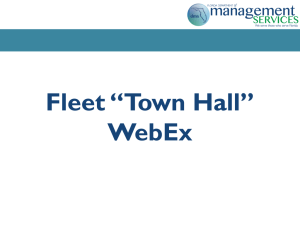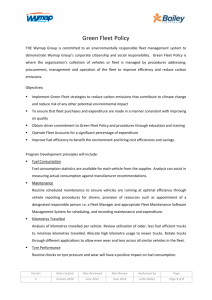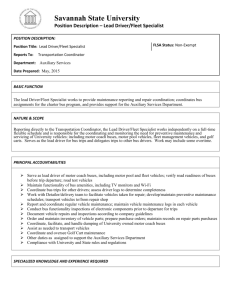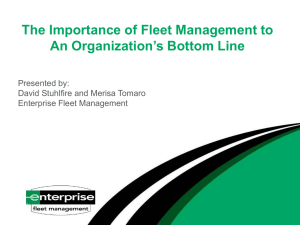FLEET Facts - Department of Management Services
advertisement
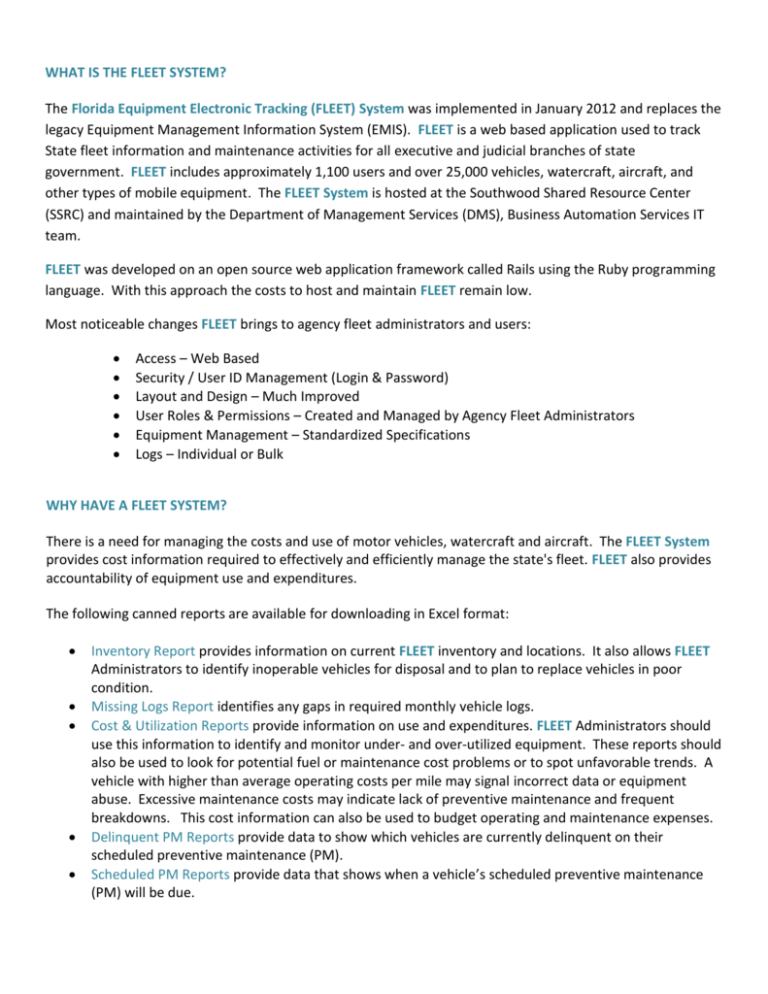
WHAT IS THE FLEET SYSTEM? The Florida Equipment Electronic Tracking (FLEET) System was implemented in January 2012 and replaces the legacy Equipment Management Information System (EMIS). FLEET is a web based application used to track State fleet information and maintenance activities for all executive and judicial branches of state government. FLEET includes approximately 1,100 users and over 25,000 vehicles, watercraft, aircraft, and other types of mobile equipment. The FLEET System is hosted at the Southwood Shared Resource Center (SSRC) and maintained by the Department of Management Services (DMS), Business Automation Services IT team. FLEET was developed on an open source web application framework called Rails using the Ruby programming language. With this approach the costs to host and maintain FLEET remain low. Most noticeable changes FLEET brings to agency fleet administrators and users: Access – Web Based Security / User ID Management (Login & Password) Layout and Design – Much Improved User Roles & Permissions – Created and Managed by Agency Fleet Administrators Equipment Management – Standardized Specifications Logs – Individual or Bulk WHY HAVE A FLEET SYSTEM? There is a need for managing the costs and use of motor vehicles, watercraft and aircraft. The FLEET System provides cost information required to effectively and efficiently manage the state's fleet. FLEET also provides accountability of equipment use and expenditures. The following canned reports are available for downloading in Excel format: Inventory Report provides information on current FLEET inventory and locations. It also allows FLEET Administrators to identify inoperable vehicles for disposal and to plan to replace vehicles in poor condition. Missing Logs Report identifies any gaps in required monthly vehicle logs. Cost & Utilization Reports provide information on use and expenditures. FLEET Administrators should use this information to identify and monitor under- and over-utilized equipment. These reports should also be used to look for potential fuel or maintenance cost problems or to spot unfavorable trends. A vehicle with higher than average operating costs per mile may signal incorrect data or equipment abuse. Excessive maintenance costs may indicate lack of preventive maintenance and frequent breakdowns. This cost information can also be used to budget operating and maintenance expenses. Delinquent PM Reports provide data to show which vehicles are currently delinquent on their scheduled preventive maintenance (PM). Scheduled PM Reports provide data that shows when a vehicle’s scheduled preventive maintenance (PM) will be due. The FLEET System provides the basic information for managing motor vehicles and other mobile equipment. The system does not make the decisions necessary to control costs and use. FLEET Administrators must decide what changes are to be made and what cost saving programs to implement. This system can, however, provide the information required to make such decisions. WHY MUST STATE AGENCIES USE THE SYSTEM? The authority for the system is Florida Statute 286.29(3) and Administrative Rule 60B-1.010 reports and records. F.S. 286.29(3): Each state agency shall ensure that all maintained vehicles meet minimum maintenance schedules shown to reduce fuel consumption, which include: ensuring appropriate tire pressures and tread depth; replacing fuel filters and emission filters at recommended intervals; using proper motor oils; and performing timely motor maintenance. Each state agency shall measure and report compliance to the Department of Management Services through the Equipment Management Information System database. (Note: A change to this statute has been submitted to update the database system name to FLEET.) Administrative Rule 60B-1.010:(1) The Division shall develop, maintain and operate an equipment management information system to meet the reporting needs of the state's motor vehicles and watercraft. The system shall provide management reports monthly to the state agencies, and shall be capable upon request of providing special reports to meet other defined needs. (2) Input to the system including but not limited to the condition, utilization, cost, fuel consumption, maintenance, and assignment of the motor vehicle and watercraft owned, leased or operated shall be provided by the agencies on forms or other means provided by or approved by the Division which address agency needs and the reporting needs of the system. This information is to be forwarded monthly to the Division's Bureau of Motor Vehicles and Watercraft so as to be received no later than the 15th day of each month, unless this date falls on a weekend or holiday. Agencies are responsible for the accuracy and timeliness of the input. (3) Agencies shall be responsible for adding new equipment to the reporting system within 30 days from the date the equipment is received, deleting equipment from the system within 30 days from the date of disposal, and making input changes and corrections to the system as required. (4) The Division shall periodically meet with major users of the system to assure that the management reporting needs of state agencies are addressed. (5) The Division shall establish reasonable charges and invoice the agencies for the forms, reports and services provided. Specific Authority 287.16(6) FS.Law Implemented 287.16(8) FS.History--New 11-28-83, Formerly 13B-3.10, 13B-3.010. WHAT EQUIPMENT MUST BE IN THE SYSTEM? Equipment Tracked in the FLEET1 System The following types of state owned and leased equipment are REQUIRED to be tracked in the FLEET system. Agencies will be invoiced a FLEET service charge for each of these required items (currently $1.75 per item per month).2 Automobiles (e.g., Coupes, Sedans, Hatchbacks, Station Wagons) Light Trucks (e.g., Pickups, Chassis-Cabs, Vans, Sport Utility Vehicles) Small Vehicle or Equipment, only if: o Designed Primarily for Transporting Persons, and, o Legal to Operate on Public Roads (i.e., with license plate) (e.g., Motorcycle) Large Vehicle (> 1 ton) or Equipment, only if: o Designed Primarily for Transporting Persons, and, o Legal to Operate on Public Roads (i.e., with license plate) (e.g., Bus, Mini-Bus) Watercraft (e.g., Boats over 12 feet in length, Airboats, Personal Watercraft) Aircraft (e.g., Airplanes, Helicopters) The following types of state owned and leased equipment are OPTIONAL for tracking in the FLEET system. Agencies will NOT be invoiced a FLEET service charge for these optional items.3 1 Medium and Heavy Trucks Small Vehicle or Equipment (except as described above) Large Vehicle (> 1 ton) or Equipment (except as described above) Tractors (to include wheel and track types) Heavy Equipment (e.g., Backhoes, Crawlers, Excavators, Loaders, Scrapers) Trailers (e.g., Boat, Utility, Cargo, Lowboy, Transport) Forklifts Other Types of Mobile Equipment (e.g., Plows, Mowers, Message Boards, Generators, Chippers, etc.) Marine Engines The Florida Electronic Equipment Tracking (FLEET) system is a web-based application used to track State fleet information and maintenance activities. The Florida Department of Management Services (DMS), Bureau of Fleet Management, is responsible for the management and administration of the FLEET system. 2 Except for aircraft and watercraft, monthly logs are required for all items that are required to be tracked in the FLEET system. Logs for aircraft and watercraft are required at least yearly. 3 Logs must be completed at least yearly for all optional items tracked in FLEET. WHAT INFORMATION IS IN THE SYSTEM? Information available consists of equipment description and monthly transaction information. A unique “Equipment Number”, assigned by the user agency, identifies each piece of equipment. The main page for each piece of equipment includes the following: Description - year, make, model, type, class description and fuel type. The description can be changed at any time using ‘Select and Equipment Specification’. Replacement Eligibility - years and units (miles/hours) at which the equipment meets replacement eligibility criteria Identification and Assignment – Unique “Equipment Number”, VIN number and assigned use code. The assigned use code indicates how the vehicle will be used (i.e. pool, law enforcement). Settings - odometer/meter type (miles/hours), the status (operational, inoperable, pending disposal, etc.) and when the vehicle requires logs (e.g., monthly for all motorized vehicles, yearly for trailers and other non-motorized vehicles) Location - location codes, city and county where vehicle is assigned. Acquisition – purchase method (conventional purchase, lease, etc.), date received, cost, begin service date and begin odometer Logs – mileage, fuel (gallons and cost) and oil (quarts and costs), equipment condition, standby and down days. Preventative Maintenance (PM) – odometer, date of services, cost, vendor, description of services. PM maintenance entries are made for regularly occurring maintenance servicing at intervals recommended by vehicle manufacturer (e.g., oil changes, transmission servicing, etc.) Work Order Maintenance (WO) – odometer, date of services, cost, vendor, description of services. Work Order maintenance entries are made for unscheduled and other non-PM maintenance activities including, but not limited to: car washes, repairs (e.g., electrical, air conditioning, water pump, etc.), replacement of parts (e.g., wiper blades, tires, battery, light bulbs, etc.). Warranties – basic or power train warranties Associated Equip. – parent/child relationships (typically used for boat/motor/trailer combinations) Misc. – Misc. The system retains monthly transaction information. When the vehicle has been disposed of, DMS will delete the equipment from the master FLEET inventory. Deleted equipment will be archived and retained with all its data. WHEN IS THE INFORMATION SUBMITTED? Information is to be submitted by the 15th day of each month, unless this date falls on a weekend or holiday. Agencies are responsible for the accuracy and timeliness of the input. Because the Florida Equipment Electronic Tracking (FLEET) System is a real time, online system, the information submitted is immediately available for viewing and reporting. WHAT’S THE COST TO USE THE FLEET SYSTEM? The rate to use the FLEET System is $1.75 per item, per month. The authority for charging for the FLEET System comes from F.S. 287.16(6) and Rule 60B-1.010(5). The rates charged cover costs associated with operating and maintaining the system. Boat Trailers and Marine Engines will not be charged a monthly FLEET System service fee since these items are treated as accessories to their associated Watercraft (Boat or Airboat) STATUTES & RULES Applicable to the acquisition, operation and disposal of state-owned motor vehicles, watercraft and aircraft. Statutes: 287 Part II: Means of Transport (287.14 – 287.20) 286.29: Climate-Friendly Public Business 24.105(13) (applies to the Department of the Lottery) 590.02(9)(a) (applies to the Florida Forest Service) Rules: 60B-1: Motor Vehicles and Watercraft Acquisition, Assignment and Use 60B-3: Disposal of Motor Vehicles, Watercraft, and Aircraft
